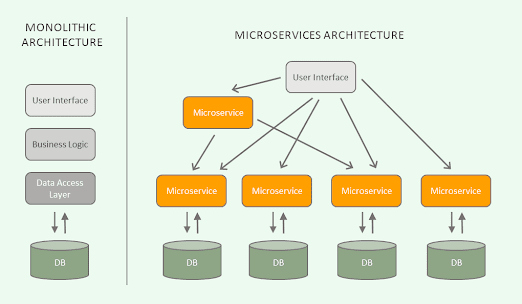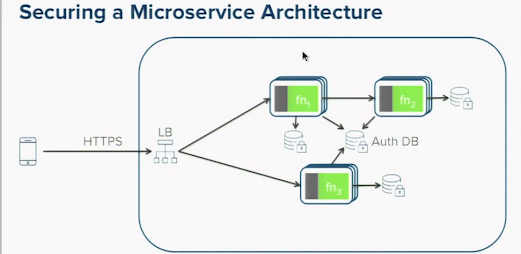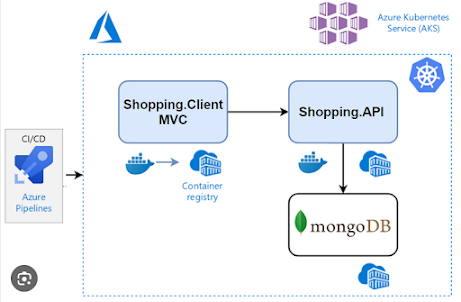Hello guys, Microservices architecture has become extremely popular in today's
technology-driven, quick-paced world because to its scalability, adaptability,
and effectiveness. They also goes hand-in-hand with today's popular Cloud
computing architecture. They are designed to make best use of Cloud Computing
power and that's why more and more companies are switching from Monolithic
architecture to Microservices. With increase adoption of Microservices, you
will also see more and more questions related to Microservices in Java
developer interviews or any other programming job interviews. In fact,
Experienced developers frequently encounter difficult interview questions that
test their knowledge of microservices and their practical use. To assist
developers in preparing for their upcoming interview, we will examine 15
advanced microservices interview questions and provide relevant real-world
examples.
2. How do you ensure data consistency among microservices in a distributed system?
Maintaining data consistency in a distributed system is challenging. One common approach is to use the Saga pattern, which breaks complex transactions into a series of smaller, manageable steps. Each step is executed within its own transaction scope, and compensating actions are defined to rollback changes in case of failures.
Real-world Example: Airbnb uses the Saga pattern to manage booking transactions across its microservices, ensuring data consistency and reliability.
3. What are the main challenges in microservices communication?
Microservices often communicate through APIs, and the challenges include network latency, service discovery, and load balancing. Developers need to choose the appropriate communication protocol, such as REST or gRPC, to optimize communication between microservices.
Real-world Example: Netflix utilizes a combination of REST and gRPC for inter-service communication in its microservices-based architecture, ensuring efficient and reliable communication.
4. How do you handle security in microservices?
Securing microservices requires a comprehensive approach. Developers must implement authentication, authorization, and data encryption. Additionally, adopting the principle of least privilege and using JWT (JSON Web Tokens) can enhance security.
Real-world Example: Uber's microservices infrastructure employs OAuth2 for authentication and authorization, guaranteeing secure access to its services.
5. What is service mesh, and how does it enhance microservices communication?
Its an infrastructure layer which is responsible for managing communication between microservices. It provides features like load balancing, traffic routing, and service discovery, freeing developers from handling these concerns in application code.
Real-world Example: Istio, an open-source service mesh tool, is widely used by companies like Lyft to simplify communication between microservices and improve observability.
6. How do you achieve fault tolerance in microservices?
Fault tolerance is essential to ensure the system remains resilient in the face of failures. Implementing retry mechanisms, circuit breakers, and timeouts are common practices to handle faults gracefully.
Real-world Example: Twitter incorporates the Hystrix library to implement circuit breakers, protecting its microservices from cascading failures and reducing system downtime.
7. Explain the concept of containerization and its role in microservices deployment.
Containerization aims to package application along with its dependencies into an isolated containers. It ensures consistency across different environments and enables seamless deployment of microservices.
Real-world Example: Google uses Docker containers to deploy and manage microservices within its Kubernetes orchestration platform, ensuring scalability and resource optimization.
8. How do you ensure monitoring and observability in microservices?
Monitoring and observability are crucial to identify issues and bottlenecks in a microservices ecosystem. Developers can employ tools like Prometheus and Grafana to collect and visualize data from various services.
Real-world Example: PayPal utilizes Prometheus and Grafana to monitor its microservices and maintain high system availability.
9. What will you describe an API gateways in microservices architecture?
API gateways act as a single entry point for client applications to interact with various microservices. They handle requests, perform authentication, and often provide caching and rate limiting.
Real-world Example: Amazon API Gateway enables seamless communication between client applications and AWS Lambda functions, simplifying microservices integration in serverless architectures.
10. How can you ensure backward compatibility in microservices?
Backward compatibility is critical when deploying updates to microservices to avoid breaking client applications. Using versioning in APIs and following semantic versioning principles can ensure smooth transitions.
Real-world Example: Microsoft maintains backward compatibility in its Azure services by following strict API versioning practices, providing a smooth experience for developers and applications.
11. What is event sourcing, and how does it support microservices?
Event sourcing is a design pattern where the state of an application is determined by a sequence of events. It allows microservices to capture and process events independently, enabling scalability and data consistency.
Real-world Example: LinkedIn implements event sourcing for its microservices, enabling real-time data processing and analytics for user interactions.
12. How do you handle database management in a microservices environment?
Each microservice typically has its own database to ensure isolation and autonomy. However, maintaining data consistency across services can be challenging. Developers may use patterns like database per service or implement event-driven architectures.
Real-world Example: Airbnb follows a database per service approach, with each microservice responsible for its data storage, ensuring independence and scalability.
13. What are the best practices for deploying microservices in a production environment?
Employing CI/CD pipelines, using container orchestration platforms like Kubernetes, implementing A/B testing, and adopting blue-green deployments are some best practices for production-ready microservices deployment.
Real-world Example: Spotify uses Kubernetes for container orchestration, allowing seamless scaling and deployment of its microservices to handle millions of active users.
14. How do you achieve load balancing in microservices?
Load balancing is crucial to distribute incoming traffic evenly among multiple instances of a microservice. Developers can use techniques like round-robin, least connections, or leverage load balancing features of cloud platforms.
Real-world Example: Google Cloud Load Balancer distributes incoming traffic intelligently across multiple instances of Google's microservices, optimizing performance and resource utilization.
15. Explain the concept of serverless computing in microservices architecture.
Serverless computing allows developers to run code without managing the underlying infrastructure. It complements microservices by enabling quick development, scaling, and cost efficiency.
Real-world Example: AWS Lambda is a popular serverless platform used by several companies, including Coca-Cola, to execute code in response to events without managing servers.
Conclusion
As the demand for microservices-based applications continues to rise, experienced developers must be well-prepared to tackle advanced interview questions. Understanding the nuances of microservices communication, security, deployment, and management, along with real-world examples, will undoubtedly equip developers to excel in their interviews and deliver robust microservices solutions in the industry.
15 Advanced Microservices Architecture Interview Questions for Experienced Developers
Here is a list of advanced Microservice questions with answers and real
world examples
1. What is the key difference between monolithic and microservices architecture?
Building an application as a single, sizable unit with all components closely integrated is known as monolithic architecture. An application is divided into smaller, independent services in a microservices architecture, which allows for independent development, deployment, and scaling.
1. What is the key difference between monolithic and microservices architecture?
Building an application as a single, sizable unit with all components closely integrated is known as monolithic architecture. An application is divided into smaller, independent services in a microservices architecture, which allows for independent development, deployment, and scaling.
Consider a standard e-commerce platform as an illustration, where the user
identification, payment processing, and product catalogue can all be handled
by different microservices.
2. How do you ensure data consistency among microservices in a distributed system?
Maintaining data consistency in a distributed system is challenging. One common approach is to use the Saga pattern, which breaks complex transactions into a series of smaller, manageable steps. Each step is executed within its own transaction scope, and compensating actions are defined to rollback changes in case of failures.
Real-world Example: Airbnb uses the Saga pattern to manage booking transactions across its microservices, ensuring data consistency and reliability.
3. What are the main challenges in microservices communication?
Microservices often communicate through APIs, and the challenges include network latency, service discovery, and load balancing. Developers need to choose the appropriate communication protocol, such as REST or gRPC, to optimize communication between microservices.
Real-world Example: Netflix utilizes a combination of REST and gRPC for inter-service communication in its microservices-based architecture, ensuring efficient and reliable communication.
4. How do you handle security in microservices?
Securing microservices requires a comprehensive approach. Developers must implement authentication, authorization, and data encryption. Additionally, adopting the principle of least privilege and using JWT (JSON Web Tokens) can enhance security.
Real-world Example: Uber's microservices infrastructure employs OAuth2 for authentication and authorization, guaranteeing secure access to its services.
5. What is service mesh, and how does it enhance microservices communication?
Its an infrastructure layer which is responsible for managing communication between microservices. It provides features like load balancing, traffic routing, and service discovery, freeing developers from handling these concerns in application code.
Real-world Example: Istio, an open-source service mesh tool, is widely used by companies like Lyft to simplify communication between microservices and improve observability.
6. How do you achieve fault tolerance in microservices?
Fault tolerance is essential to ensure the system remains resilient in the face of failures. Implementing retry mechanisms, circuit breakers, and timeouts are common practices to handle faults gracefully.
Real-world Example: Twitter incorporates the Hystrix library to implement circuit breakers, protecting its microservices from cascading failures and reducing system downtime.
7. Explain the concept of containerization and its role in microservices deployment.
Containerization aims to package application along with its dependencies into an isolated containers. It ensures consistency across different environments and enables seamless deployment of microservices.
Real-world Example: Google uses Docker containers to deploy and manage microservices within its Kubernetes orchestration platform, ensuring scalability and resource optimization.
8. How do you ensure monitoring and observability in microservices?
Monitoring and observability are crucial to identify issues and bottlenecks in a microservices ecosystem. Developers can employ tools like Prometheus and Grafana to collect and visualize data from various services.
Real-world Example: PayPal utilizes Prometheus and Grafana to monitor its microservices and maintain high system availability.
9. What will you describe an API gateways in microservices architecture?
API gateways act as a single entry point for client applications to interact with various microservices. They handle requests, perform authentication, and often provide caching and rate limiting.
Real-world Example: Amazon API Gateway enables seamless communication between client applications and AWS Lambda functions, simplifying microservices integration in serverless architectures.
10. How can you ensure backward compatibility in microservices?
Backward compatibility is critical when deploying updates to microservices to avoid breaking client applications. Using versioning in APIs and following semantic versioning principles can ensure smooth transitions.
Real-world Example: Microsoft maintains backward compatibility in its Azure services by following strict API versioning practices, providing a smooth experience for developers and applications.
11. What is event sourcing, and how does it support microservices?
Event sourcing is a design pattern where the state of an application is determined by a sequence of events. It allows microservices to capture and process events independently, enabling scalability and data consistency.
Real-world Example: LinkedIn implements event sourcing for its microservices, enabling real-time data processing and analytics for user interactions.
12. How do you handle database management in a microservices environment?
Each microservice typically has its own database to ensure isolation and autonomy. However, maintaining data consistency across services can be challenging. Developers may use patterns like database per service or implement event-driven architectures.
Real-world Example: Airbnb follows a database per service approach, with each microservice responsible for its data storage, ensuring independence and scalability.
13. What are the best practices for deploying microservices in a production environment?
Employing CI/CD pipelines, using container orchestration platforms like Kubernetes, implementing A/B testing, and adopting blue-green deployments are some best practices for production-ready microservices deployment.
Real-world Example: Spotify uses Kubernetes for container orchestration, allowing seamless scaling and deployment of its microservices to handle millions of active users.
14. How do you achieve load balancing in microservices?
Load balancing is crucial to distribute incoming traffic evenly among multiple instances of a microservice. Developers can use techniques like round-robin, least connections, or leverage load balancing features of cloud platforms.
Real-world Example: Google Cloud Load Balancer distributes incoming traffic intelligently across multiple instances of Google's microservices, optimizing performance and resource utilization.
15. Explain the concept of serverless computing in microservices architecture.
Serverless computing allows developers to run code without managing the underlying infrastructure. It complements microservices by enabling quick development, scaling, and cost efficiency.
Real-world Example: AWS Lambda is a popular serverless platform used by several companies, including Coca-Cola, to execute code in response to events without managing servers.
Conclusion
As the demand for microservices-based applications continues to rise, experienced developers must be well-prepared to tackle advanced interview questions. Understanding the nuances of microservices communication, security, deployment, and management, along with real-world examples, will undoubtedly equip developers to excel in their interviews and deliver robust microservices solutions in the industry.















No comments :
Post a Comment